As the first Resident of Singapore (1819-23), his picture is plastered over our history books.
 Together with Raffles, the man who founded modern Singapore, they are etched in the minds of local students. I remember Farquhar as the balding guy in No. 1 uniform.
Together with Raffles, the man who founded modern Singapore, they are etched in the minds of local students. I remember Farquhar as the balding guy in No. 1 uniform.However, these two ang mohs who share the same chapter in our books ended up buay gam with each other. Raffles fired Farquhar over differences in administration and the issue was escalated by Farquhar to the Court of Directors of the East India Company. In his rebuttals, Raffles downplayed Farquhar's contributions and portrayed him only as an assistant in the formation of the Singapore settlement.
For his role in building the Settlement, you'd expect at least a road to be named after him. Unfortunately there is none. The last one was expunged about a decade ago.
So where was Farquhar's road?
Its location was brought to my attention while I was checking the old street directory for another blog entry.
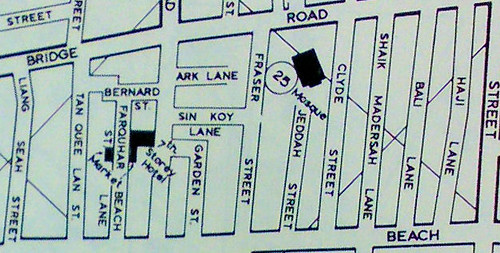
Initially I thought it was "Farquhar Beach". The name is too incredulous, so I looked harder. Actually it is Farquhar Street and Beach Lane.
But strange! Why is this street, itself short enough, divided into two stretch? Furthermore, where does Farquhar Street end and Beach Lane start?
The old street directory doesn't help much. With no landmarks, any division along a road is just arbitrary.
Let's look at what the aerial photo has to offer.
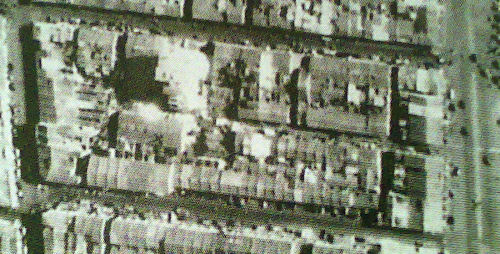
Taken in the 1950s. The plot of land is bounded by North Bridge Road(left), Rochor Road(top), Beach Road(right) and Tan Quee Lan Street(bottom). Farquhar Street and Beach Lane runs along the middle. Bernard Street is also visible.
I can see two possible divisions. If we walk down from 7th Storey Hotel to Beach Road, there are two lanes on the left that will lead you to Rochor Road. So there could be a street sign on the shophouse wall that says "Beach Lane" on either T-junction.
Interestingly, Farquhar Street and Beach Lane are also known by their Hokkien names. According to Toponymics, Farquhar Street is known as go cho lut bo bue hang and Beach Lane as thih pa sat khut thau hang.
I'm not that familiar with dialects, so I'm guessing the former means "梧槽路 dead end" and the latter mean something like "to go 铁巴刹, walk there".
The thih pa sat (铁巴刹) is Clyde Terrace Market which I'd probably cover in a later post. The association of Farquhar Street with Rochor Road (梧槽路) is a bit confusing until we realize Bernard Street is also known by the same name.
However, it is still puzzling why Bernard Street is a blind alley off Rochor Road. The street is wide enough for cars to pass. From the old street directory and aerial photo, it looks possible to drive your car from Tan Quee Lan Street to Rochor Road via Bernard Street. Or vice versa if the street is one way.
In fact, I found evidence of double yellow lines along Bernard Street, Farquhar Street and Beach Lane. Not sure whether they were added later. Still, it is pretty amazing to see road markings on expunged roads.
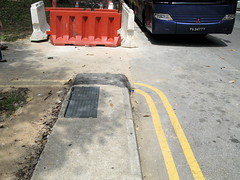

Left: Bernard Street junction with Tan Quee Lan Street. Right: The view after turning into Bernard Street.
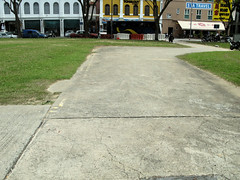
From road to pavement. Today pedestrians walk on it, but still possible for vehicles to travel to reach the backlane of New 7th Storey Hotel.
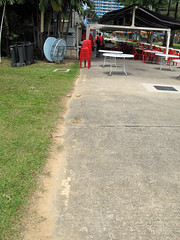
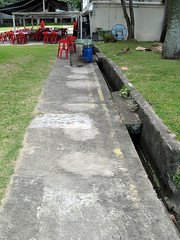
Left: Farquhar Street from Bernard Street. Right: Farquhar Street from Beach Lane side. In both pictures, New 7th Storey Hotel is visible
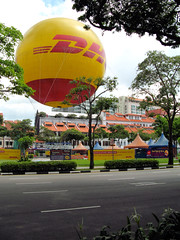
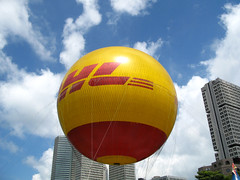
Opened in May 2006, this 6500 cubic metres balloon flying at 180m (48 storeys) is the world's largest tethered helium balloon.

Source: UcanFly website. The balloon is operated by the same guys who brought us Duck and Hippo tours.
If you take the Balloon up, you would be able to make out the outline of the three roads. But do hurry, because the Balloon will operate until August 2008....
Back to the ground. At its junction with Beach Road, Beach Lane, or what was once Beach Lane, is still visible.

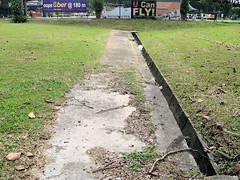
Left: Beach Lane. Right: Beach Lane close up, note the yellow lines again.
Looking at the photos again, i realize Beach Lane is not as well preserved as its neighbors. Only part of the road is visible. Further up, the hotel actually uses Farquhar Street for its backlane dining experience.
From research, I found out Beach Lane is known also as 面线巷. Translated, it would be "Mee Sua Lane". Perhaps this place was famous for Mee Sua last time.
Back to the topic. I started this post about William Farquhar, so let's end it with him. Do you know how Bernard Street got its name?
The street got its name after Francis James Bernard who held multiple titles like Master Attendant (1819-20), Chief of Police (1820-24) and also owner of Singapore Chronicle, Singapore's first newspaper.
But wait! What has he got to do with William Farquhar??
Simple .... he was the Colonel's son-in-law. :P















2 comments:
Sounds like he kena stripped off of all his credits in his part of establishing Singapore. LOL. How come he doesn't get much recognition as Raffles? :S Just cos buay gum then 'strike' him off ah? Wah.... tsk tsk tsk.
Interesting post.
I think it was our fault too.
We chose to honour the later ang mohs like Crawford and Pickering.
Governors like Clementi and Shenton got a town/district named after them.
Post a Comment